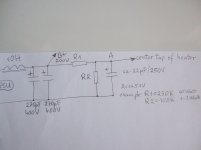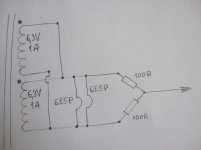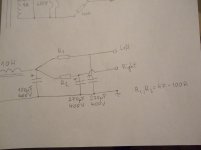The 6E6P has Rp=1.3K
OPT loading is usualy 3 times Rp.(triode mode)
Parallel SE - Rp=.65K - OPT=1.9K-2.5K
Parallel PP - Rp=1.3K - OPT=3.5K-5K
Amplification factor is 34. So with the usual 2V output of CD player, DAC you have to turn up the volume louder. Only if the dynamics are too slow, it would be a sign that the gain is too low. Your speakers should have 96db+ sensitivity. Don't forget to solder pin 8 to cathode.
OPT loading is usualy 3 times Rp.(triode mode)
Parallel SE - Rp=.65K - OPT=1.9K-2.5K
Parallel PP - Rp=1.3K - OPT=3.5K-5K
Amplification factor is 34. So with the usual 2V output of CD player, DAC you have to turn up the volume louder. Only if the dynamics are too slow, it would be a sign that the gain is too low. Your speakers should have 96db+ sensitivity. Don't forget to solder pin 8 to cathode.
Member
Joined 2009
Paid Member
Try this:
"DC elevation: DC elevation is often used when a valve in the circuit has a high cathode voltage. The heater voltage is elevated to a higher level to avoid exceeding the maximum heater-cathode voltage rating of the valve. This is done simply by 'adding' a DC voltage to the heater supply. The heaters still operate at 6.3V (or whatever you're using), but the AC component 'floats' on top of a DC voltage.
This method is also used to reduce audible heater hum.........."
For more text and diagrams, see here:
The Valve Wizard
"DC elevation: DC elevation is often used when a valve in the circuit has a high cathode voltage. The heater voltage is elevated to a higher level to avoid exceeding the maximum heater-cathode voltage rating of the valve. This is done simply by 'adding' a DC voltage to the heater supply. The heaters still operate at 6.3V (or whatever you're using), but the AC component 'floats' on top of a DC voltage.
This method is also used to reduce audible heater hum.........."
For more text and diagrams, see here:
The Valve Wizard
Bigun is right, it's mainly used for reducing hum. And at critical heater voltage as in datasheet. This is not the case here.
My ugly drawing on paper: Value for the cap across R2 is only a suggestion. Higher possible.
This will be no night and day difference. You'll get a more natural tone and resolution. I have used it with a two resistors center tap. Desolder your two 100R resistors from ground and connect them to point A.
Or do it as in my second drawing. Since 6E5P/6E6P are indirect heated, parallel the heater pins on both sockets and do the same with the two 6,3V secondary windings. The 1A is to low for both tubes. Each winding has a inner beginn side and outer end side. Connect inner to inner side and outer to outer side of each winding.
I havn't yet used your method of grounding only one side of winding. I don't want to make it complicate.
I find your two 270µF psu caps a little bit much. One cap should be enough for good bass and dynamics. Too much capacity can slow dynamics.
If you have another 100µF cap i have a suggestion for a stereo psu.
Johann
My ugly drawing on paper: Value for the cap across R2 is only a suggestion. Higher possible.
This will be no night and day difference. You'll get a more natural tone and resolution. I have used it with a two resistors center tap. Desolder your two 100R resistors from ground and connect them to point A.
Or do it as in my second drawing. Since 6E5P/6E6P are indirect heated, parallel the heater pins on both sockets and do the same with the two 6,3V secondary windings. The 1A is to low for both tubes. Each winding has a inner beginn side and outer end side. Connect inner to inner side and outer to outer side of each winding.
I havn't yet used your method of grounding only one side of winding. I don't want to make it complicate.
I find your two 270µF psu caps a little bit much. One cap should be enough for good bass and dynamics. Too much capacity can slow dynamics.
If you have another 100µF cap i have a suggestion for a stereo psu.
Johann
Attachments
Hi Lauscher,
thank you for your replay.
As I read, this method is used for hum control.
I use only one 100 ohm resistor from heating to the ground.
But, I have absolutely no hum, on approx. 96 dB/1W speakers.
I will try to modify, and than listen to the mod.
Did you try to open your drawings, I only can see the thumb nail, the big picture is "white" for me.
thank you for your replay.
As I read, this method is used for hum control.
I use only one 100 ohm resistor from heating to the ground.
But, I have absolutely no hum, on approx. 96 dB/1W speakers.
I will try to modify, and than listen to the mod.
Did you try to open your drawings, I only can see the thumb nail, the big picture is "white" for me.
Here a picture of my hole system with the 6E5P amp.
The sound is so nice, I like it very much.
I have to ask, where did you get that sleeving for the power cable? I absolutely love it, it looks like a snake!
Ryssen: Good, then you don't need to create a artificial center tap with 2 resistors. You can use it for grounding or elevating heater.
Tubeman813: Scroll up and down, from left to right when you open the picture. Don't know what setups your browser/computer has.
I don't want to confuse you. No hum cancelling needed here. A few years back i found the suggestion, that the 6C45 sounds better with elevated heater. Tried it on my 6E6P-DR and can report the same.
Johann
Tubeman813: Scroll up and down, from left to right when you open the picture. Don't know what setups your browser/computer has.
I don't want to confuse you. No hum cancelling needed here. A few years back i found the suggestion, that the 6C45 sounds better with elevated heater. Tried it on my 6E6P-DR and can report the same.
Johann
I can easy open the pictures. I can't help you with the setups of your browser/computer.
To all others: Can you open the pictures with schematics ?
I have the same schematic as you. Only don't use RC on cathode and lower voltage.(180V) Two SiC diodes in serie with cathode to ground. The change from RC to Cree diodes on cathode made the biggest improvement.
A 5K C-core OPT from Automatic Electric in Holland.
To all others: Can you open the pictures with schematics ?
I have the same schematic as you. Only don't use RC on cathode and lower voltage.(180V) Two SiC diodes in serie with cathode to ground. The change from RC to Cree diodes on cathode made the biggest improvement.
A 5K C-core OPT from Automatic Electric in Holland.
I can easy open the pictures. I can't help you with the setups of your browser/computer.
To all others: Can you open the pictures with schematics ?
I have the same schematic as you. Only don't use RC on cathode and lower voltage.(180V) Two SiC diodes in serie with cathode to ground. The change from RC to Cree diodes on cathode made the biggest improvement.
A 5K C-core OPT from Automatic Electric in Holland.
Can you share the schema...i'm very interested too.just to have reference..I have 20 pcs of them but not the dry type....
Sorry, i have made a mistake. I meant 3 SiC diodes stacked in serie.(180V) At 200V - 4 pieces would be better.
JunM: Do a google search: tube diode(led) biasing. This way you learn it.
I am too busy to draw again a schematic. If one single 6E6P has too low power for your speakers, then this spud amp is useless for you. You can increase power with PP and parallel, but the amplification factor remains the same. Forget it with 92db speakers.
Don't buy the 6E5P-I ! The I means impulse version, wich is not good for audio.
I only have DR version. DRY/DRU has golden pins. I would buy first better OPT and only with good equipment you may hear the difference.
JunM: Do a google search: tube diode(led) biasing. This way you learn it.
I am too busy to draw again a schematic. If one single 6E6P has too low power for your speakers, then this spud amp is useless for you. You can increase power with PP and parallel, but the amplification factor remains the same. Forget it with 92db speakers.
Don't buy the 6E5P-I ! The I means impulse version, wich is not good for audio.
I only have DR version. DRY/DRU has golden pins. I would buy first better OPT and only with good equipment you may hear the difference.
Hi Lauscher,
Could and would you share the schematic of your 6E6P Amp?
What OPT do you use?
I cannot open your attached pictures, only thumb nail visible.
Aloha to everyone.
Tubeman, do you like your 6E6P amp better then your 6C45?
Is there any progress? You got the schematic?
Very inerested in this project.
Thank you.
I can easy open the pictures. I can't help you with the setups of your browser/computer.
To all others: Can you open the pictures with schematics ?
I have the same schematic as you. Only don't use RC on cathode and lower voltage.(180V) Two SiC diodes in serie with cathode to ground. The change from RC to Cree diodes on cathode made the biggest improvement.
A 5K C-core OPT from Automatic Electric in Holland.
Hi Lauscher,
where did you purchase the SiC diodes in Germany (?).
Regards
Peter
Hi pieroh,
at conrad - Cree C3D2060F.
Later i used standard self bias resistor + bypass cap. The cap was the special - Vishay 128 sal-rpm - 47µF - 68µF, 6.3V - 10V.
Great bass, dynamics and very transparent. Better than all film caps i have tried. In Germany at distrelec.
But the lithium battery in serie with grid from juanitox can be even better. No experience.
I don't use the spud amp anymore - no evolution.
Good luck Johann
at conrad - Cree C3D2060F.
Later i used standard self bias resistor + bypass cap. The cap was the special - Vishay 128 sal-rpm - 47µF - 68µF, 6.3V - 10V.
Great bass, dynamics and very transparent. Better than all film caps i have tried. In Germany at distrelec.
But the lithium battery in serie with grid from juanitox can be even better. No experience.
I don't use the spud amp anymore - no evolution.
Good luck Johann
- Home
- Amplifiers
- Tubes / Valves
- Spud Amplifier with 6E5P Tube


